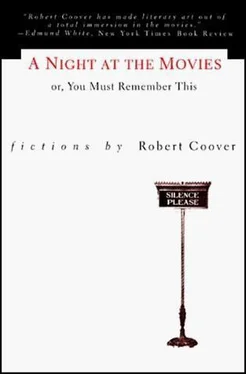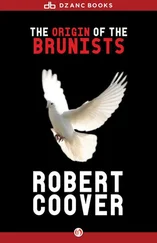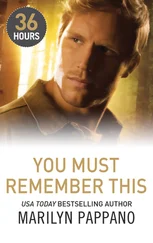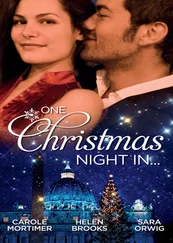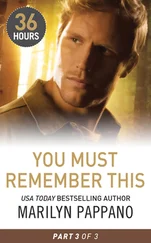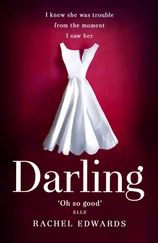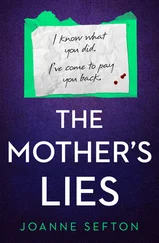The camera pans steadily past the shuttered window to the door, from which an old woman is now emerging. She is stooped almost double, dressed heavily in black, with thick skirts to her ankles. Her shoes, of which we see only the tips from time to time, are highly polished. A heavy black shawl, draped over her head, hides her features from view. She pulls the door to with a soft click, the same click as heard before but not so amplified, and, keeping her back to the camera, moves off down the old rutted street. The camera hesitates, then follows at a discreet distance.
The old woman hobbles along through side street after rutted side street; camera motion is erratic and the camera has some difficulty keeping her in the range of the lens. Silence, except for the sound of her feet shuffling through the dust of the street. When she turns corners, as she frequently does, the camera loses sight of her for a moment, but on making the same turn, always relocates her a few paces ahead. Almost imperceptibly, the deserted streets widen, the way improves, the motion grows more even.
Suddenly, upon turning a last corner: the cathedral steps, looming high over the camera — rapid zoom back through the open square in front of the cathedral and down the main street, until the frame encompasses the entirety of the cathedral once more. The old woman is halfway up the now-distant steps, taking each of them one by one, doubled over, holding her skirts, a slow and difficult climb. At last, she reaches the top, the cathedral doors yawn open to receive her, and she passes through them to be swallowed up by the darkness within.
Distantly, very faintly: a dull throbbing tympanic music, measured, gloomy, like the cavernous beating of a sullen but determined heart. Very slow zoom in toward the cathedral, music augmenting slightly.
Sudden close-up of the open front portals of the cathedral, a priest standing in them, the funeral music bursting in thunderingly at the same instant. The face of the priest, staring out upon the village, is that seen earlier in the window of the old woman's cottage: high-domed, pale, drawn, with thin tense lips, large eyes gazing out, perhaps in anger or judgment, or even: in terror.
To the heavy measure of the dirge, the priest, still staring straight ahead, descends the cathedral steps. The camera maintains a tight focus on the priest, but visible behind him are other people, dressed in black, moving to the same somber rhythms, carrying what is eventually seen to be a casket. Upon reaching the bottom of the steps, the priest moves across the open square and on down the main street, toward the camera.
Camera focus now moves off the priest, drifting back over his shoulder to encompass the three men, walking side by side behind him. Like the priest, they are gaunt and solemn, dressed in black robes, their faces in fact identical to that of the priest. They stare straight ahead, walking slowly to the beat of the funeral music.
Behind these three men comes the casket: huge, black, ornately carved, elegant, polished and gleaming in the pervading white light of the overcast day, held aloft on the shoulders of twelve men, six on each side. Like the priest's three assistants, they are duplicates of the priest: the same pale forehead and high cheekbones, large staring eyes, etc. They wear black suits, fresh white flowers in their lapels. They advance, under their burden, with an exaggerated rocking motion from side to side, to the cadence of the dirge. One of the pallbearers winces briefly or perhaps starts to smile and quickly suppresses it.
Behind the coffin come the mourners, all women, all stooped and covered with black shawls and thick black skirts. Dust rises and drifts about their shuffling feet, but the glitter of the toes of their hard-polished shoes is still visible through it. One of the women glances up at the camera briefly: again, the same face. There are many women following the casket, their bowed backs like a dark sea, like black sheep in a fold. One woman seems more agitated in her grief than the others, her shoulders shaking; she glances up: she is laughing, silently, or perhaps is about to sneeze. Or weep. She ducks her head again.
The camera zooms slowly back from the women and tilts up to the casket, now directly overhead, rocking back and forth. As it swings away, there is a play of lights and shadows over the detail of the carving on the side, but as it rocks back over the camera, it becomes only a massive black shape against the plain white sky.
Slow elevation of the camera until it is level with the rocking casket: it rocks away from the camera, then swings toward it. Under it, the pallbearers stare expressionlessly ahead. The coffin is lidless.
Continued elevation of the camera until it is directly over the casket, pointed down at the advancing procession. The dead man is, not surprisingly, identical to the others, though his eyes bulge a bit more starkly, seem filmed over and sightless, and his lips, dried and cracked, are pulled back over his teeth in a disconcerting death-grin. He is laid out on soft velvety cushions, dressed in formal black attire much like that of the pallbearers, a wilted white flower in his lapel. His thin white hands, the fingernails long, are crossed over his breast.
Cut to the same camera position as in the first scene after the titles, village in the middle distance, etc. The funeral procession, led by the priest and his three assistants, approaches by way of the main street out of the village. The music, having diminished abruptly at the cut, now slowly augments as the procession advances. The road is lined with mourners, all dressed in black, the women wearing black shawls, the men dressed in black suits, their heads bowed. There are hundreds of these mourners, several deep all along the road, from here near the camera all the way back to the cathedral. When any of them chances to glance up, he or she reveals a face identical to that of the priest, the pallbearers, dead man, etc. One of them seems to be biting his lip, another rolls her eyes, another's shoulders are gently shaking, etc., three or four such exceptions amid the multitudes.
The procession pulls abreast of the camera, then passes on, the music augmenting to full volume, then slowly diminishing. The camera, in the road, wheels around to follow — at extreme close range — and then pauses to allow the old women to pass by. White dust, scuffed up by their polished shoes, stirs hazily around their skirts.
As the last of the old women passes, the camera tracks along behind them, now watching from the rear as the procession with its rocking casket moves slowly toward a cluster of cypresses in the middle distance. But for these cypresses, the fields are barren. The camera follows the procession at a discreet distance, steadily at first, then slowly commencing to imitate the to-and-fro motion of the casket.
The cemetery with its cypresses is enclosed by an ancient stone wall. The procession and then the camera pass through its gate and under the lugubrious trees. The walls and cypresses seem to bend toward the center of the frame as the camera passes beneath them, then vanish in a sweep at the corners. The cemetery is littered with broken tombstones, dried wreaths, little silver frames containing photographs of the dead (again, always the same face). Weeds, flowers, grass grow wildly. The procession halts at the mouth of an open grave, freshly dug, a shovel rammed into the mounds of excavated earth, and the music, abruptly, breaks off.
Cut to a close-up of the priest's face, staring down into the open grave, the mourners filing silently into the cemetery behind him, filling it completely. There is a faint rustling sound, like that made by the wind. The camera zooms slowly back to encompass more of the cemetery: there are thousands of mourners crammed in here. They make small furtive motions with their hands at their faces, then clasp them at their breasts. The sound of the wind fades away to silence.
Читать дальше
